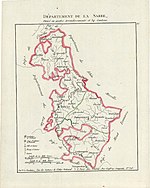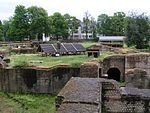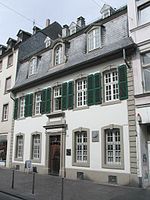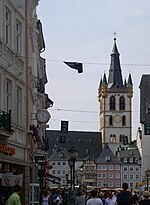St. Matthias' Abbey
1802 disestablishments in the Holy Roman EmpireBasilica churches in GermanyBenedictine monasteries in GermanyChristian organizations established in 1922Minor basilicas in Germany ... and 5 more
Monasteries in Rhineland-PalatinateReligion in TrierRoman Catholic churches in TrierRomanesque architecture in GermanyTombs of apostles

St. Matthias' Abbey is a Benedictine monastery in Trier, Rhineland-Palatinate, Germany. The abbey church, a Romanesque basilica, is a renowned place of pilgrimage because of the tomb of Saint Matthias the Apostle, after whom the abbey is named, located here since the 12th century, and the only burial of an apostle in Germany and north of the Alps. The abbey was originally named after Saint Eucharius, first Bishop of Trier, whose tomb is in the crypt. The church has been given the status of a minor basilica.
Excerpt from the Wikipedia article St. Matthias' Abbey (License: CC BY-SA 3.0, Authors, Images).St. Matthias' Abbey
Abteiplatz, Trier Matthias (Süd)
Geographical coordinates (GPS) Address Nearby Places Show on map
Geographical coordinates (GPS)
| Latitude | Longitude |
|---|---|
| N 49.738055555556 ° | E 6.6319444444444 ° |
Address
Abteiplatz
Abteiplatz
54290 Trier, Matthias (Süd)
Rhineland-Palatinate, Germany
Open on Google Maps











